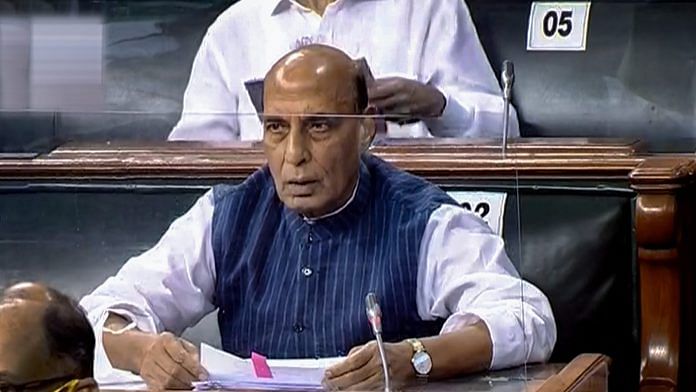New Delhi: The Narendra Modi government issued its first formal, high-level statement on the India-China standoff when Defence Minister Rajnath Singh spoke on the issue in Parliament Tuesday, said ThePrint’s Editor-in-Chief Shekhar Gupta on episode 568 of ‘Cut The Clutter’.
Gupta said that day two of the monsoon session began with a bang due to Singh’s speech, which was both conciliatory in its tone and candid by nature. This was an anomaly because usually statements by India on issues of national security (excluding Pakistan) were extremely cautious in nature.
He also referred to an article by Chinese scholar Qian Feng in the Global Times, China’s state-run newspaper, which was published on 13 September. In the article, Qian wrote an “interesting and loaded line” that the Indian defence minister is playing the bad cop while the Indian foreign minister is playing the good cop.
The article anticipated that Singh would talk tough on the India-China standoff, and said that in India, the political government decides what the military does and therefore the onus of the India-China standoff is on the Indian political leadership.
In the Rajya Sabha, according to Gupta, Singh displayed some aspects of a bad cop, like a clenched fist, but his tone was very conciliatory.
Also read: India ‘extra’ alert along LAC stretch, Pakistan border as China delays corps commander talks
Rajnath Singh’s speech
In his speech, Singh, in an unusually candid manner, admitted that there was no commonly delineated Line of Actual Control (LAC) and that China did not recognise traditional or geographic boundaries.
He said that it was very clear that a diplomatic relationship between India and China could not progress if there was trouble and instability on the border.
The defence minister added that keeping in mind past protocols, both the countries kept troops at a certain minimum distance from the LAC, or at least their perceptions of the LAC.
However in the beginning of April, it was China that violated the protocols when they moved large bodies of troops, equipment and ammunition.
In Parliament, Singh mentioned that India’s intelligence agencies picked up these movements and reported the same. Shortly after, India’s normal patrolling patterns were disrupted by the Galwan standoff.
Depsang Plains not mentioned in speech
However, Gupta notes that Singh did not mention the Depsang Plains in his entire speech. Several critics have pointed out that India has lost most of the territory in this region.
According to Gupta, it seemed like the government view was that no territory was lost in Depsang but instead they see it as continuing interference in Indian patrols to areas where both sides used to patrol.
There are large areas of clashing perceptions in Depsang Plains where both sides used to patrol in the past. While one used to patrol, the other backed off.
To that extent, it was similar to what Pangong Tso lake was between Finger 2 and Finger 8 before the standoff. Both sides would patrol the area, but now the Chinese claim ownership by pitching deep and heavy upto Finger 4.
Similarly, India is also not confining itself to Finger 2 and has pitched itself till Finger 4.
However, the difference in Depsang is that the Chinese started interfering with Indian patrols so the latter are not entering the region now but even the Chinese have not come and positioned forces there.
This is perhaps the reason why Singh did not mention the plains in his speech.
Also read: China miscalculated India resolve, needs exit strategy now, says former Ladakh corps commander
Current standoff different from past instances: Rajnath
Singh also talked about the saiyam (patience and calm) and shaurya (valour) of Indian troops while responding to Chinese actions.
He mentioned Colonel B. Santosh Babu and the 19 other soldiers who died during combat at the Galwan stand-off in June. Gupta said that Singh’s speech was assertive and not provocative.
The defence minister also spoke about India’s position on the standoff with China at the LAC in three simple points. These were — respecting the current de facto LAC, not making any unilateral changes in the current status on the border and to abide by all agreements to stabilise the situation and keep the border situation peaceful.
In his speech in Parliament, Singh explained why the standoff between China was different compared to previous occasions. First, the level of violence by Chinese troops was very high. Second, the trouble broke simultaneously at many more border points than in the past and finally because the scale of troop deployment was very different.
However, Singh reassuringly said that for all the Chinese troop deployment, India had carried out counter troop deployment.
In conclusion, Gupta said that the ball was now in China’s court to end the standoff as they had started it by violating agreements and carrying out exercises and shifting equipment.
Watch the latest episode of CTC here:




Is there a Paki flag on his head?